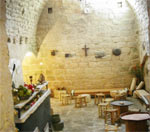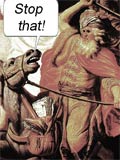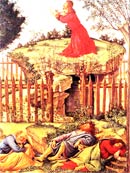A Surfeit of Jesuses! – But No "Jesus of Nazareth"
Was there a Jesus? Of course there was a Jesus – many!
The archetypal Jewish hero was Joshua (the successor of Moses) otherwise known as Yehoshua (Yeshua) bin Nun (‘Jesus of the fish’). Since the name Jesus (Yeshua or Yeshu in Hebrew, Iesous in Greek, source of the English spelling) originally was a title (meaning ‘saviour’, derived from ‘Yahweh Saves’) probably every band in the Jewish resistance had its own hero figure sporting this moniker, among others.
Josephus, the first century Jewish historian mentions no fewer than nineteen different Yeshuas/Jesii, about half of them contemporaries of the supposed Christ! In his Antiquities, of the twenty-eight high priests who held office from the reign of Herod the Great to the fall of the Temple, no fewer than four bore the name Jesus: Jesus ben Phiabi, Jesus ben Sec, Jesus ben Damneus and Jesus ben Gamaliel. Even Saint Paul makes reference to a rival magician, preaching ‘another Jesus’ (2 Corinthians 11,4). The surfeit of early Jesuses includes:
Jesus ben Sirach. This Jesus was reputedly the author of the Book of Sirach (aka ‘Ecclesiasticus, or the Wisdom of Jesus the Son of Sirach’), part of Old Testament Apocrypha. Ben Sirach, writing in Greek about 180 BC, brought together Jewish ‘wisdom’ and Homeric-style heroes.
Jesus ben Pandira. A wonder-worker during the reign of Alexander Jannaeus (106-79 BC), one of the most ruthless of the Maccabean kings. Imprudently, this Jesus launched into a career of end-time prophecy and agitation which upset the king. He met his own premature end-time by being hung on a tree – and on the eve of a Passover. Scholars have speculated this Jesus founded the Essene sect.
Jesus ben Ananias. Beginning in 62AD, this Jesus had caused disquiet in Jerusalem with a non-stop doom-laden mantra of ‘Woe to the city’. He prophesied rather vaguely:
Too strange to be a coincidence!
Jesus ben Saphat. In the insurrection of 68AD that wrought havoc in Galilee, this Jesus had led the rebels in Tiberias (“the leader of a seditious tumult of mariners and poor people” – Josephus, Life 12.66). When the city was about to fall to Vespasian’s legionaries he fled north to Tarichea on the Sea of Galilee.
Jesus ben Saphat. In the insurrection of 68AD that wrought havoc in Galilee, this Jesus had led the rebels in Tiberias (“the leader of a seditious tumult of mariners and poor people” – Josephus, Life 12.66). When the city was about to fall to Vespasian’s legionaries he fled north to Tarichea on the Sea of Galilee.
Jesus ben Thebuth. A priest who, in the final capitulation of the upper city in 69AD, saved his own skin by surrendering the treasures of the Temple, which included two holy candlesticks, goblets of pure gold, sacred curtains and robes of the high priests. The booty figured prominently in the Triumph held for Vespasian and his son Titus.
Jesus ben Saphat. In the insurrection of 68AD that wrought havoc in Galilee, this Jesus had led the rebels in Tiberias (“the leader of a seditious tumult of mariners and poor people” – Josephus, Life 12.66). When the city was about to fall to Vespasian’s legionaries he fled north to Tarichea on the Sea of Galilee.
Jesus ben Gamala. During 68/69 AD this Jesus was a leader of the ‘peace party’ in the civil war wrecking Judaea. From the walls of Jerusalem he had remonstrated with the besieging Idumeans (led by ‘James and John, sons of Susa’). It did him no good. When the Idumeans breached the walls he was put to death and his body thrown to the dogs and carrion birds
Jesus ben Thebuth. A priest who, in the final capitulation of the upper city in 69AD, saved his own skin by surrendering the treasures of the Temple, which included two holy candlesticks, goblets of pure gold, sacred curtains and robes of the high priests. The booty figured prominently in the Triumph held for Vespasian and his son Titus.
But was there a crucified Jesus?

Nazareth – The Town that Theology Built
The 'Lord's Prayer'? – No, just re-hashed Jewish litany

Babble
Not a Prayer
Invisible Friend
CNN in the Garden of Gethsemane?
Makes You Think

Where Did They Get Their Ideas From?
PS: High Priest John kills his brother "Jesus" in the Temple!
Sources
- Paul Johnson, A History of the Jews (Phoenix Grant, 1987)
- John P. Meier, A Marginal Jew – Rethinking the Historical Jesus (Doubleday, 1991)
- Josephus, The Jewish War (Penguin, 1959)
- Leslie Houlden (Ed.), Judaism & Christianity (Routledge, 1988)
- Riane Eisler, The Chalice & the Blade (Harper Collins, 1987)
- Geza Vermes, The Changing Faces of Jesus (Allen Lane, 2000)
- A. N. Wilson, Jesus (Harper Collins, 1993)
- Ian Wilson, Jesus: the Evidence (Weidenfeld & Nicolson, 1984)
- Alvar Ellegard, Jesus One Hundred Years Before Christ (Century, 1999)
- Johannes Lehmann, The Jesus Report (Souvenir Press, 1972)
Related articles
What's in a Name?
Artificial
No Evidence
Non-Christian Testimony?
Josephus – c 37 – c 100 AD
Tacitus – c 55 – c 117 AD
Suetonius – c 69 – 140 AD
Chrestus?
Not a Word
Ancient Prototype

Star Struck
'Born under star' from soothsayer with talking donkey!

Regarded as Fraudsters Even in the 2nd Century:
In the Land of Nod

Did the Rabbis Know Jesus?
St Paul even had a friend called "Jesus"!
Last word
